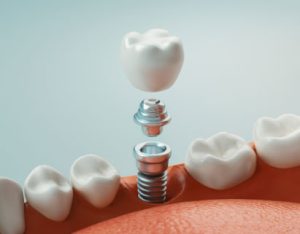Oral Surgery

Replacing Missing Teeth with Implants
A healthy mouth is an important component of a healthy body. A missing tooth can affect your bite, speech, appearance, and your ability to chew. Functioning on your remaining teeth creates increased workloads and increases the chance they will wear out prematurely.
 Dental implants are often the most ideal permanent solution for missing teeth. Dental implants have been used for decades and have become the gold standard for replacing missing teeth. They not only replace the missing tooth but also provide a sturdy foundation and keep the jaw healthy and strong. Unlike bridges, no healthy teeth are damaged or compromised. Dental Implants can be attractive, stable, and comfortable.
Dental implants are often the most ideal permanent solution for missing teeth. Dental implants have been used for decades and have become the gold standard for replacing missing teeth. They not only replace the missing tooth but also provide a sturdy foundation and keep the jaw healthy and strong. Unlike bridges, no healthy teeth are damaged or compromised. Dental Implants can be attractive, stable, and comfortable.
Dentures and bridges are initially less expensive, yet their affordability can be short-lived. These solutions can require repair and replacement every 5-10 years. Therefore, they are often more expensive over time.
When comparing the cost of dental implants to other tooth replacement methods such as dentures and bridges, it is important to consider the longevity offered by dental implants. Implants are a permanent non-removable option that is comfortable and hassle free.
Overview of Implant Placement
The process to place an implant takes less than an hour. The implant itself is the first step in the process to replacing your tooth. Once the implant is in place, the healing phase takes a few months until the jawbone fully integrates with the implants surface.
Prior to surgery, you may be given antibiotics and for comfort during the procedure either an IV or nitrous oxide (laughing gas). A local anesthetic will also be used to numb the area of treatment.
Once the anesthesia is working, the surgeon makes a small incision in the gums and then creates space for the implant with a special tool. The titanium implant is gently inserted. Often the top of the implant can be seen in the early stages of healing.
